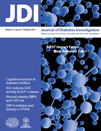Localization of hepatocyte nuclear factor-4α in the nucleolus and nucleus is regulated by its C-terminus
Abstract
Aims/Introduction: Mutations in hepatocyte nuclear factor-4α (HNF4α) lead to various diseases, among which C-terminal deletions of HNF4α are exclusively responsible for maturity onset diabetes of the young 1 (MODY1). MODY is an autosomal dominant disease characterized by a primary defect in insulin response to glucose, suggesting that the C-terminus of HNF4α is important for pancreatic β-cell function. To clarify the role of the C-terminus of HNF4α, changes in cellular localization and the binding ability to its regulator were examined, specifically in the region containing Q268, which deletion causes MODY1.
Materials and Methods: Cellular localization of mutant HNF4α were examined in monkey kidney 7 (COS7), Chinese hamster ovary, rat insulinoma and mouse insulinoma cells, and their binding activity to other proteins were examined by fluorescence resonance energy transfer (FRET) in COS7 cells.
Results: Although wild-type HNF4α was localized in the nucleoplasm in transfected cultured cells, Q268X-HNF4α was located predominantly in the nucleolus. Deletion analysis of the C-terminus of HNF4α showed that the S337X-HNF4α mutant, and other mutants with shorter amino acid sequences (S337-K194), were mostly localized in the nucleolus. HNF4α mutants with amino acid sequences shorter than the W192X-HNF4α mutant gradually spread to the nucleoplasm in accordance with their lengths. The A250X-HNF4α mutant was capable of causing the accumulation of HNF4α or the small heterodimer partner (SHP), one of the HNF4α regulators, in the nucleolus. However, the R154X-HNF4α mutant did not have binding ability to wild-type HNF4α or SHP, and thus was seen in the nucleus.
Conclusions: The C-terminus sites might play a key role in facilitating the nucleolar and subnucleolar localization of HNF4α. (J Diabetes Invest, doi: 10.1111/j.2040-1124.2012.00210.x, 2012)




